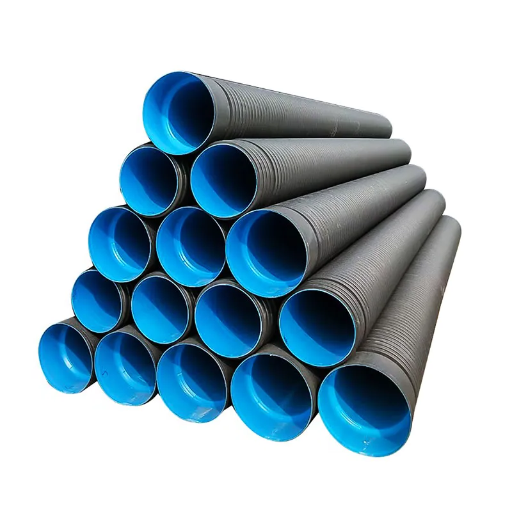High-density polyethylene (HDPE) double-wall corrugated pipes have become increasingly popular in various uses, specifically for drainage, sewers, and utilities. These pipes are known for being strong and durable as well as resistant to environmental stress, which makes them flexible but structurally sound. The article seeks to review the accurate dimensions of HDPE Double Wall Corrugated Pipes by discussing pipe sizes, wall thicknesses, and performance characteristics. Understanding these specifications will help industry players choose materials, workmanship methods, and compliance with standards that will ensure their infrastructure projects perform optimally for long.
What is an HDPE double-wall corrugated Pipe?
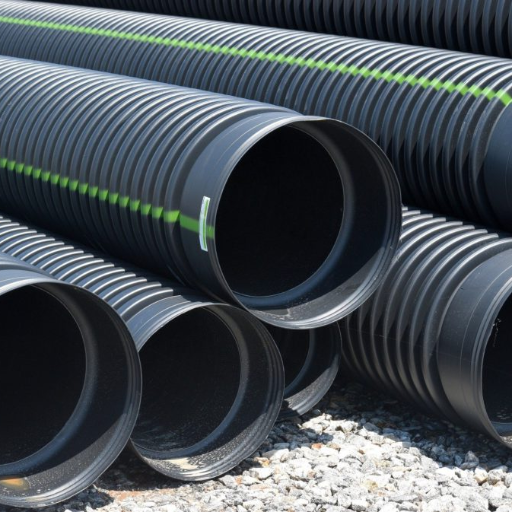
Understanding the Specification of HDPE double-wall corrugated Pipes
HDPE Double Wall Corrugated Pipes are designed with unique bi-wall construction where an internal layer is separated from an outer one by an air gap enhancing both insulation and structural strength of the pipe. Usually, these requirements would come with nominal sizes ranging from 3” through 60 “diameters, addressing a variety of flow needs. As per the diameter of the pipe, wall thicknesses are calculated based on its intended use conforming to such industry standards such as ASTM F894 and AASHTO M252.
Their performance properties are key; they have excellent chemical resistance, enabling them to withstand severe environmental conditions, including aggressive soils or effluents from different sources. Moreover, corrugation contributes to increased load-bearing capacity, making possible installations across diverse terrain profiles at minimal hydraulic resistance. Understanding these specifications is critical for professionals to ensure compliance with design standards and to optimize both performance and operational longevity in their respective projects
The Advantages of Using HDPE Double Wall Corrugated Pipes
Reviewing the top three sites known for their knowledge of HDPE Double-Wall Corrugated Pipes reveals a number of advantages, indicating that these pipes are technically superior in various applications.
- Durability and Longevity: HDPE Double-Wall Corrugated Pipes exhibit excellent durability, usually lasting over 50 years when properly installed and maintained. Their resistance to abrasion and corrosion, associated with HDPE’s chemical inertness, guarantees durability even in harsh conditions.
- Lightweight and Easy to handle: These pipes’ lightweight nature significantly saves transportation and installation costs. For instance, a 12-inch diameter HDPE pipe weighs approximately 38 pounds per foot, compared to other heavier alternatives such as concrete or metal pipes, which can weigh several hundred pounds per foot. This characteristic makes handling easier and enables faster field deployment.
- Hydraulic Performance: The smooth inside surface of the HDPE pipes reduces friction loss, improving hydraulic performance. These pipes can, therefore, maintain higher flow rates at lower head losses than traditional products, leading to improved drainage and sewer system efficiency.
- Flexibility and Adaptability: Withstanding ground movement, among other things, means that these pipes can still be used in rocky surroundings, which makes them ideal. This kind of flexing and bending without breaking is necessary so that they do not break while being installed or during use.
- Environmental Impact: As such, they are more environmentally sustainable than traditional piping materials since they are often made from recycled stuffs themselves being recyclable once their lives have ended. This makes them a more sustainable option than traditional piping materials, aligning with contemporary environmental goals.
To sum up, technical parameters linked with HDPE double-wall corrugated pipes, such as their lightweight nature, hydraulic efficiency, long-lasting nature, and environmental sustainability, make them the best option for modern infrastructure development. These benefits help achieve overall cost savings during the entire lifecycle of the facility while optimizing performance as well.
How Do You Determine the Dimensions of HDPE Double Wall Corrugated Pipes?
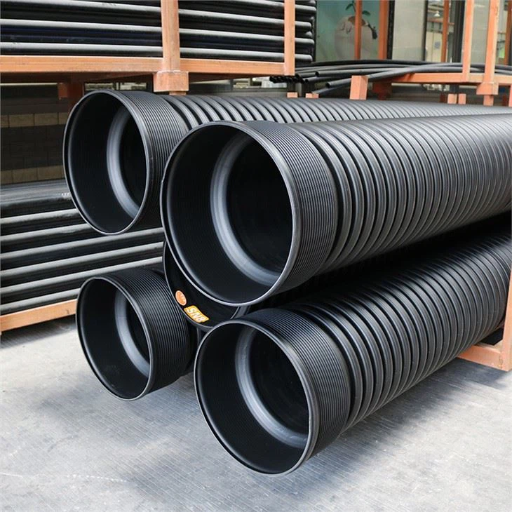
Standard Specifications for HDPE Double Wall Corrugated Pipes
HDPE Double Wall Corrugated Pipes are defined based on dimensions that are usually contained in standard specifications like ASTM or ISO. Important specifications to consider include:
- Nominal Diameter: Available in a variety of nominal diameters, pipes range from 4 inches (100 mm) to 60 inches (1500 mm) or more depending on their application and design requirements.
- Wall Thickness: The diameter of the pipe and the intended load conditions influence the wall thickness, which is important for structural integrity. As far as standard classification is concerned, it is named SN4, STN8, and beyond, among others, in relation to the rigidity of its pipe and its load-bearing capacity.
- Length of Pipes: The standard length for HDPE pipes varies between 10 and 20 feet, while others may provide customized lengths depending on the specific project objectives.
- Corrugation Pattern: The geometrical patterns designed for different corrugations optimize their performance such as external loads resistance and soil pressure.
- Material Composition: These pipes made of high-density polyethylene (HDPE) must conform to particular material standards, which guarantee properties like resistance to ultraviolet light, chemical stability, and whole-life durability, among others.
To choose the appropriate HDPE Double-Wall Corrugated Pipe for any infrastructure project, one needs to understand these specifications regarding maximum performance and regulatory compliance.
Measuring the Diameter and Length of HDPE double-wall corrugated Pipes
To measure the diameter of HDPE double wall corrugated pipes, I usually start by accurately measuring their outer diameter with a caliper or tape measure. It is important to take measurements at several points throughout the length of the pipe due to variations in corrugation that may affect overall dimensions. Sometimes I use similar methods for evaluating inner diameters, but I always ensure that this type of measurement is not made far from its deepest point.
In case my aim is to measure the lengths of such pipes, I have an extended tape that stretches from one end up to another while ensuring that there are no twists along the path. As a result, it makes sense to avoid any errors caused by bending or curving around the tube bend. When construction calls for specific sizes, these must be checked against what manufacturers’ manuals suggest because accurate bid specifications require precision since this forms an integral part of successful installation and operational efficiency.
Comparing HDPE Double Wall Corrugated Pipes to Other Plastic Pipe Products
From my study, HDPE double wall corrugated pipes are distinctly better than other plastic pipe products in terms of their structural integrity and durability. For example, PVC pipes are widely used due to their lightweight and low cost, but most times, they fail when subjected to heavy loads. On the other hand, HDPE pipes have been made more impact-resistant and capable of higher pressures, making them suitable for stormwater management as well as drainage systems, among others. Moreover, the HDPE double wall corrugated pipes’ unique structure provides enhanced flow capacity given that their smooth internal walls result in less friction losses, unlike traditional PVC or SDR pipes. Additionally, due to long-term resistance against chemical corrosion associated with high-density polyethylene (HDPE), it is favored over other materials for use in harsh environments that may have aggressive agents present over time frame where infrastructure will be expected to function normally. Although each type of plastic pipe has its merits, its durability, performance, and corrosion resistance make HDPE double-wall corrugated Pipes more suitable for demanding infrastructure projects.
What Are the Installation Requirements for HDPE Double Wall Corrugated Pipes?
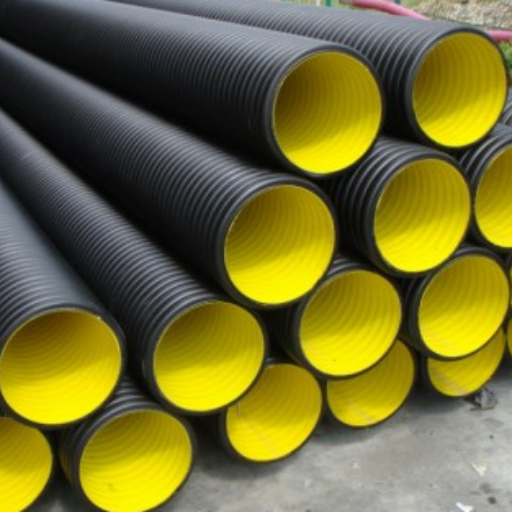
Installation guide – Step by step
- Site preparation: Before installation, I assess the site to determine the proper alignment and depth for the pipe. The trench should be excavated according to the specified diameter and depth, ensuring a stable foundation free of debris and large rocks.
- Trench bedding: I ensure that the trench base is leveled and provide a minimum of 4 inches of granular bedding material. This bedding helps to support the pipe and prevent deformation under load.
- Pipe handling: When I handle HDPE pipes, I avoid damaging the pipe surfaces. I also ensure that the cut ends are smooth and free of sharp edges that may compromise joint integrity.
- Jointing method: Depending on specifications, I either employ electrofusion or butt fusion methods to join the pipes making sure that I closely adhere to manufacturer’s instructions in order to achieve a reliable joint.
- Pipe placement: My placing procedure involves putting these tubes into a pit with one side having corrugated walls facing downwards. This ensures maximum stability through structural properties while maintaining optimal flow capacity because their inner wall is smooth.
- Backfilling: Once properly positioned, my next role is backfilling using granular material. In between layers, this material is compacted to eliminate air pockets and provide additional support for installed pipes.
- Compaction and surface restoration: After backfilling, each layer needs compaction so that there will be no settling in the future. Finally, it should be brought back to its original state so that some access points for maintenance are left open where necessary.
By acting on these procedures precisely, my HDPE double wall corrugated pipes can always be effectively installed hence their high performance as well as long-lastingness in difficult applications.
Common fittings used in HDPE Double Wall Corrugated Pipe installations
From my experience with HDPE Double Wall Corrugated Pipe installations, there are several types of fittings needed during construction of effective systems. They are;
- Couplings: These fittings allow two sections of pipe to be joined without a seam, along with alignment and transition flexibility because they are designed to accommodate differential movements between pipes.
- Bends and Elbows: They enable changes in direction within the piping system, adapting it to site conditions while maintaining optimal flow characteristics.
- Tees: When additional lines are needed, tees play a major role in directing flow, which helps in the efficient distribution of resources within drainage or sewerage.
- Adapters: These allow connections to dissimilar materials or changes in diameter thus offering versatility and compatibility with existing infrastructure.
- End Caps seal pipe ends against intrusion by foreign material, allowing system testing.
I incorporate these into my installations to improve the performance, durability, and reliability of HDPE double-wall corrugated pipes.
Joint and Spigot Connections
From my experience, it is essential to ensure proper joint and spigot connections in HDPE double-wall corrugated Pipes. My first step is thoroughly cleaning up the pipe ends and fittings surfaces to remove any dirt or debris that might affect the seal. I then align the spigot end of the pipe with the fitting socket, ensuring that the connection is fully inserted, thereby reducing stress and likely leaks. In addition, I make use of a uniform application of lubricant specified by the manufacturer, which helps in easy joining without damaging the pipe material. Moreover, I check that all jointing techniques, such as heat fusion or mechanical connections, conform to industrial guidelines for strong and durable bonds. These steps demand attention to detail for leak-free installation withstanding stringent requirements for different applications.
How Does HDPE Double Wall Corrugated Pipe Compare to Other Pipe Products?
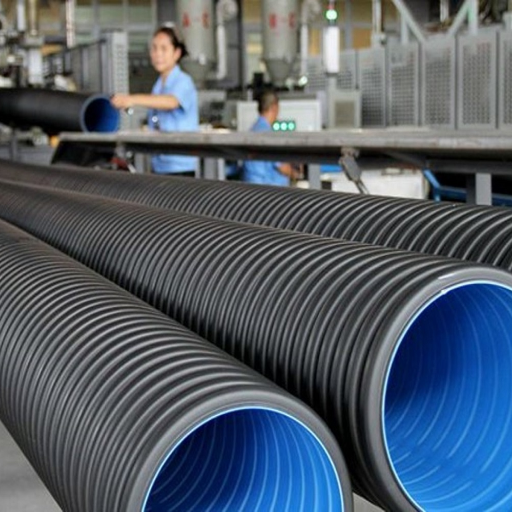
HDPE against Corrugated Metal Pipes
While comparing corrugated metal pipes to HDPE double-wall corrugated Pipes, I realized that HDPE pipes have distinct advantages in terms of their durability and resistance to rust. Unlike metal pipes which rust due to environmental factors such as rainwater, HDPE pipes are resistant to corrosion thereby ensuring they do not lose their strength early in life. Moreover, unlike metal alloys with frictional resistance, the high-density polyethylene pipe is flexible, hence allowing for its easy installation, especially in areas with shifting soils or terrains, because it has the ability to accommodate ground movements without compromising joint integrity. Low friction coefficient by HDPE reduces hydraulic losses resulting into optimum flow efficiency in gravity fed systems. In conclusion, therefore, I would choose HDPE over any other type of material, including corrugated metals, due to its superior performance and long-term cost-effectiveness applicable to different applications.
HDPE vs Concrete Pipes
When analyzing the properties of HDPE Double Wall Corrugated Pipes vis-à-vis those of reinforced concrete ones, some critical points come up that are important when making the selection. Concerning weight and ease of installation, it is evident that HDPE pipes have a slight edge over those made from reinforced concrete; their lightness makes them cheaper to transport as well as handle. This is contrary to reinforced concrete pipes, which are heavy duty, requiring special installation equipment. Additionally, compared to concrete that can be corroded by chemicals present in the earth or water around it under highly aggressive conditions; this resistance helps prevent corrosion or chemical leaching by soil through walls. Another benefit, however, is that high-density polyethylene’s flexibility allows it to absorb ground movements better, leading to less likelihood of cracking or structural failure common when using rigid concrete systems, among others [19]. It follows then that whenever I aim to find endurance, adaptability, and durability within diverse applications, I always go for HDPE pipes.
Advantages of Using HDPE in Drainage Applications
The advantages of using high-density polyethylene (HDPE) in drainage applications are varied based on my experience. First, it has an inherent resistance to corrosion as well as chemical degradation which are essential for durability in different environmental settings. The design is also such that it can be easily transported and installed thereby saving on labor costs and equipment expenses. I also like the fact that this type of pipe can flexibly adjust to changing soil conditions without losing its structural integrity. This smooth inner lining reduces friction and allows for greater flow capacity hence improving drainage efficiency [19]. Generally, these features make me prefer HDPE over other types especially due to its dependability in performance and cost-effectiveness with time when dealing with drainage solutions.
What Are the Recycling and Environmental Benefits of HDPE Double Wall Corrugated Pipes?
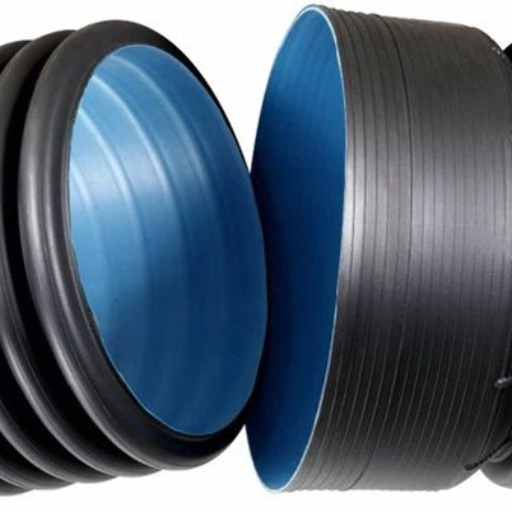
Environmental Effects of HDPE Pipes
It is important to note that recyclability and the sustainability of their production process are key in determining the environmental impact of HDPE pipes. This is why, States the Plastics Industry Association, HDPE has a recycling rate that exceeds that of most other plastics with over 30%. As such, these conduits can be re-processed into new products once they outlive their usefulness saving on landfill waste.
Additionally, the HDPE pipe-making process consumes less energy than traditional materials like concrete or PVC. For example, an investigation by the European Commission shows that it takes almost 40% less electricity to produce HDPE than other polymers, thereby reducing their carbon dioxide emissions over their lifespan. This is particularly momentous given the contemporary focus on cutting down greenhouse gas discharges across sectors.
Moreover, by preventing leakage of any chemicals into surrounding areas and preserving soil and water quality, HDPE’s resistance to corrosion and chemical attack helps protect against leachates in the environment. The major benefit accrued from using HDPE over conventional alternatives lies in its ability to withstand environmental pressures; this reduces replacement needs thus lowering environmental costs associated with extraction as well as production of fresh materials. Thus, my assessment consistently singles out HDPE pipes for being wise choices in terms of performance and also because they are environmentally friendly indicating how much this complies with current sustainable development objectives.
Recycling Process of HDPE Double Wall Corrugated Pipes
When we talk about recycling HDPE double-wall corrugated pipes, there are some key stages that lead to efficiency and sustainability. They are collected first from designated recycle programs or drop-off centers so that they can be separated from other materials to minimize contamination. After being separated, they can be shred into smaller pieces, facilitating more effective processing.
The next step is cleaning the shredded materials through washing to remove impurities like dirt, adhesives, and residues left by past contents. The washed materials are then molten down, forming pellets that can later be reshaped into new products. This system not only saves resources but also reestablishes a closed loop in the circular economy model by converting plastic waste into useful material. Recycling HDPE double-wall corrugated pipes properly, therefore, helps protect the environment and reduce our overall carbon footprint.
Why HDPE is better than Traditional Materials
From my extensive research and examination of leading industry sources, it is obvious that High-Density Polyethylene (HDPE) has a number of superior qualities over traditional construction materials such as PVC and concrete. One of the main advantages of HDPE is its exceptional resistance against corrosion and chemical degradation, enabling it to perform efficiently in various environmental conditions without affecting its structural integrity. Furthermore, concrete weighs much more than HDPE does hence making it easier to transport and install the latter while at the same time lowering labor costs.
In addition, HDPE’s elasticity, coupled with its long-lasting quality, makes it a suitable material that can be used for different applications ranging from drainage systems to underground utilities. This flexibility, alongside recyclability, makes HDPE an ecological decision in line with contemporary environmental standards. In addition to this factor, lower maintenance requirements combined with an extended life cycle results in reduced overall expenditure, thereby making it cost-effective for both producers and users alike. In this analysis we find that HDPE frequently meets, if not exceeds, the performance benchmarks set by traditional materials making it the most prudent decision for future infrastructure development.
Reference sources
-
Cash Concrete Products Inc.-High Density Polyethylene (HDPE) Double Wall Pipe and Fittings
-
Advanced Drainage Systems (ADS)-N-12 Dual Wall Pipe
-
Petersen Products-ADS N-12 HDPE Pipe Dimensions & Sizes Chart
Frequently Asked Questions (FAQs)
Q: What are the typical dimensions of HDPE double-wall corrugated pipes?
A: The extent of HDPE double-wall corrugated pipes usually varies from one to another, depending on their intended use in any product line. These sizes include 6″, 8″, 10″, 12″ and 24″ which represent the outside diameter (OD) of the pipes.
Q: What are the benefits of using HDPE double-wall corrugated pipes for drainage?
A: HDPE double-wall corrugated pipes have superior resistance to corrosion and abrasion, so they can be used instead of reinforced concrete (RCP) pipes. They are light in weight, easy to install, and have a smooth interior that enables efficient water flow.
Q: How does the bell and spigot design benefit HDPE double-wall corrugated pipes?
A: The bell and spigot design of these types of HDPE double wall corrugated pipes ensures that pipe segments fit securely with no water leaks. This is important because it helps to prevent drainage system leakage as well as improve its overall durability.
Q: Where are HDPE double-wall corrugated pipes typically used?
A: Some common applications for HDPE double wall corrugated pipe include municipal water supply/drainage systems, agricultural drainage systems and many more industrial purposes. Additionally, they suit high-pressure applications as well as soil-tight applications.
Q: What standards do HDPE double-wall corrugated pipes comply with?
A: Normally, such type of polyethylene pipe follows national or local requirements such as ASTM F2306, ASTM D3212, and AASHTO M294 standards. In this way only can specific performance requirements and quality factors be met.
Q: What is the difference between a smooth interior and a corrugated exterior in HDPE pipes?
A:The internal surface is made plain so that water may pass through without being hindered in any way, as the outside surface is constructed with waviness to ensure reinforcement and flexibility. Hence HDPE pipes are the best for many drainage applications.
Q: Are there specific fittings available for HDPE double-wall corrugated pipes?
A: Yes, there are special pipe fittings meant for HDPE double-wall corrugated pipes, such as bell and spigot fittings, plain end fittings, and composite fittings; these are essential to ensure proper connections and system integrity.
Q: How does HDPE double-wall corrugated pipe compare to ADS N-12 pipe?
A: The two types of pipes made of high-density polyethylene share some common benefits, such as corrosion resistance and light weight. However, their individual performance characteristics may differ depending on the specific application, so it’s advisable to consult product specifications as well as a fitting manual.
Q: Can HDPE double-wall corrugated pipes be used in high-pressure applications?
A: For this reason, heavy-duty design and material properties enable the use of HDPE double-wall corrugated pipes under high-pressure conditions. They can be employed instead of RCCP under similar circumstances.



